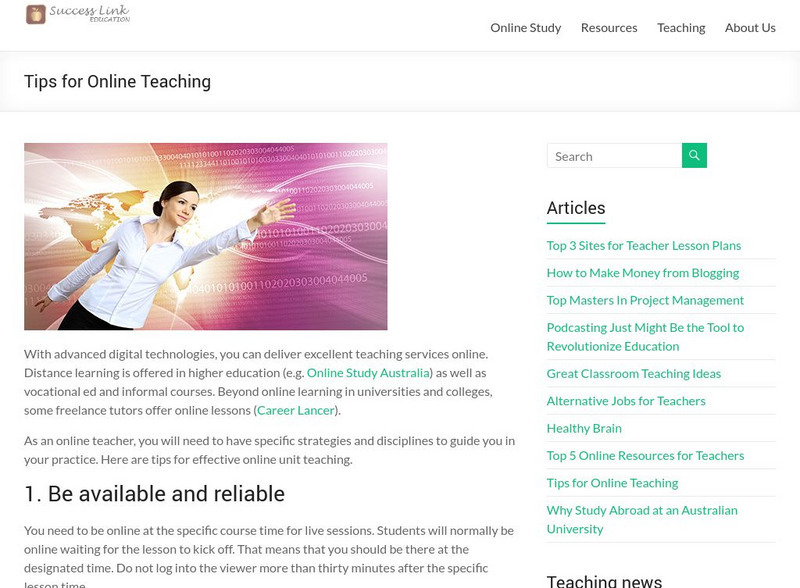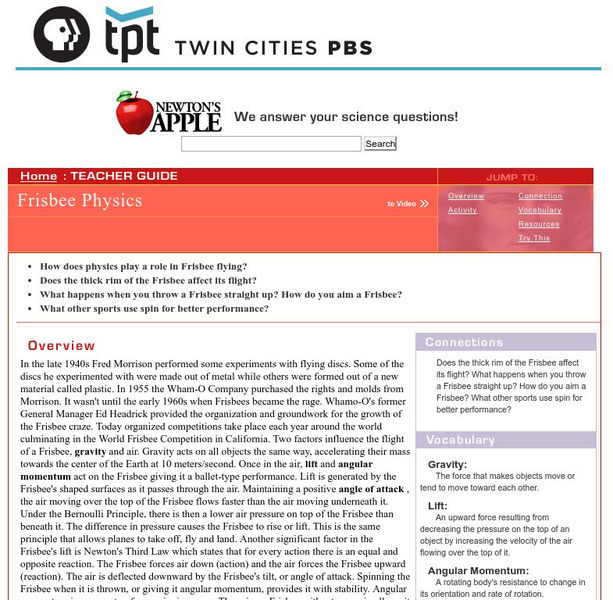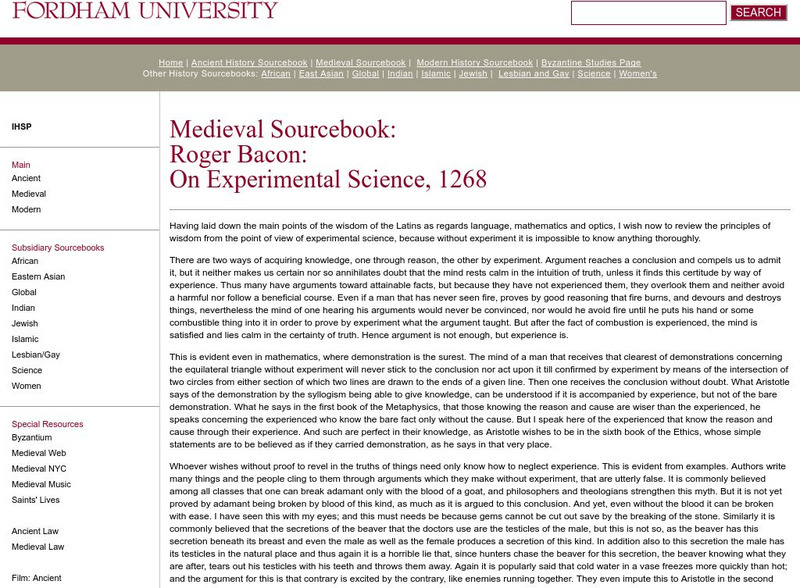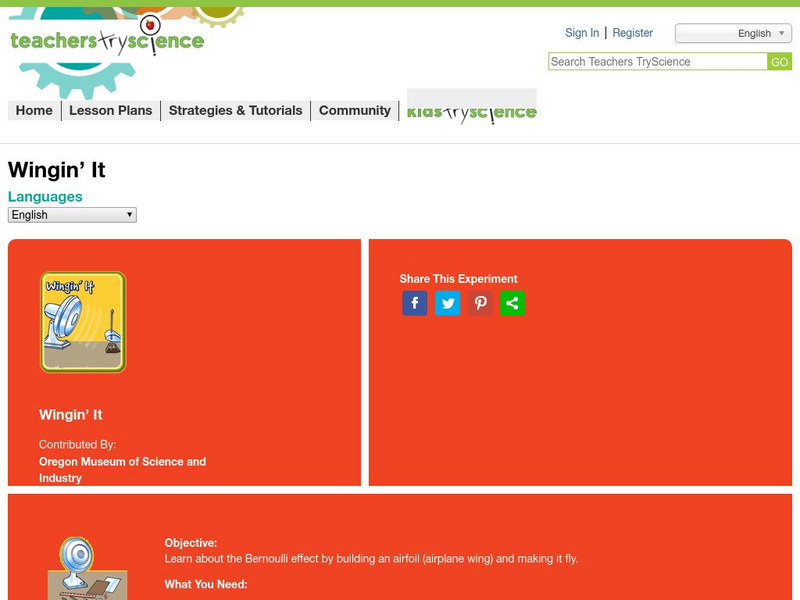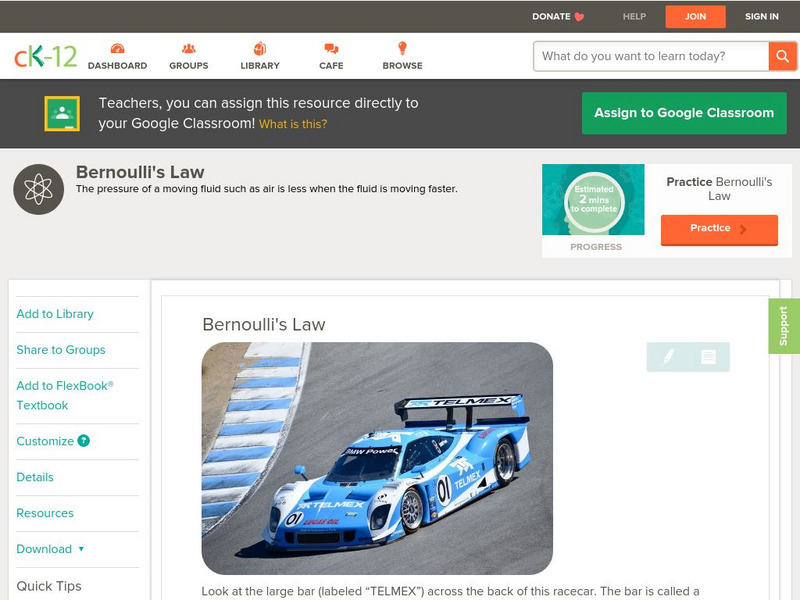PBS
Pbs Teachers: Scientific American: Flying Free: Winging It
Explore flight and the science behind lift and wing shape by creating two paper airplanes - a monoplane glider and a ring-wing glider.
Alabama Learning Exchange
Alex: Building a Paper Airplane Using Bernoulli's Principle
This is a culmination activity used after students have studied Bernoulli's Principle as part of a unit on forces and fluids. Students will use the Internet, textbooks, library resources and their cooperative learning group to design...
TeachEngineering
Teach Engineering: Up, Up and Away! Airplanes
The airplanes unit begins with a lesson on how airplanes create lift, which involves a discussion of air pressure and how wings use Bernoulli's Principle to change air pressure. Following the lessons on lift, students explore the other...
Science Buddies
Science Buddies: The 'Ultimate' Science Fair Project: Flying Disk Aerodynamics
Tossing a Frisbee with your friends is a great way to have fun in the sun. As you practice your throws and become more accurate, you're learning about the aerodynamics of Frisbee flight intuitively. You're learning the body mechanics...
Science Buddies
Science Buddies: Up, Up, and Away in Your Own Hot Air Balloon!
In this science fair project, students will make hot-air balloons using a toaster and dry-cleaning bags, and see how the size of the balloon affects its flight. The Science Buddies project ideas are set up consistently beginning with an...
NASA
Ltp: Rocket Principles
Excellent NASA sponsored site on the principles of rockets. The site relates Newton's 3 laws to the flight of a rocket. Site also has links to activities related to rockets in addition to links about practical rocketry.
PBS
Pbs Teachers: Delta Wing Flyer Experiment
Investigate principals of flight by building a delta wing flyer from soda straws and newspaper. Test it to see how well it flies.
TeachEngineering
Teach Engineering: Windy Tunnel
The purpose of this activity is to demonstrate Bernoulli's Principle as it relates to winged flight. The students will use computers to see the influence of camber and airfoil angle of attack on the lift.
University of Minnesota
The Physics of Flight: Bernoulli's Principle
Discusses air flow around the wing of a plane and its effect upon the lift and drag forces. Focuses on the application of Bernoulli's principle to wing design and the subsequent airfoil shapes.
Success Link
Success Link: Flying Into Spring
Here are two lesson plans that apply geometric concepts to design objects. The first involves students as a group following step by step instructions on making a kite. After the review of geometry vocabulary, in cooperative groups the...
NASA
Nasa: Aerodynamics Index
Are you studying or teaching Aerodynamics? This page acts as an index to all the terminology related to this topic. Clicking on any title will open a page with a colored slide and a scientific explanation of the contents. Animated,...
TryEngineering
Try Engineering: Water Rocket Launch
The main focus of this lesson is learning about aerospace engineering and the principles of rocketry. To accomplish this, students will work in teams to design, build, and launch a rocket made out of a soda bottle, then present their...
MadSci Network
Mad Scientist Network: How Do Planes Fly Upside Down?
Question and answer regarding the physics principles that apply to a plane flying upside down.
PBS
Newton's Apple: Frisbee Physics
This teacher's guide from Public Television's Newton's Apple discusses and illustrates the physics principles governing the flight of a frisbee. Includes teacher lesson plans, activity ideas, discussion questions, and information about...
Other
See How It Flies: Airfoils and Airflow
One chapter from a larger site dedicated to explaining the physics of flight. Numerous diagrams show the flow of air around an airfoil.
Exploratorium
Exploratorium: Hoopster
Students create their own airplane using straws and other materials and learn the principles of aerodynamics.
Internet History Sourcebooks Project
Fordham University: Medieval Sourcebook: Roger Bacon
Fordham University provides this site with information on "On Experimental Science, 1268." Roger Bacon reviews "the principles of wisdom from the point of view of experimental science."
TeachEngineering
Teach Engineering: May the Force Be With You: Lift
Learners revisit Bernoulli's Principle (Lesson 1 of the Airplanes unit) and learn how engineers use this principle to design airplane wings. Airplane wings create lift by changing the pressure of the air around it. This is the first of...
Teachers TryScience
Teachers Try Science: Wingin' It
Learn about the Bernoulli effect by building an airplane wing, or airfoil, and making it fly.
Science and Mathematics Initiative for Learning Enhancement (SMILE)
Smile: Lab Work: Come Fly With Me
This site by the Illinois Institute of Technology lets students use a vacuum cleaner hose, ping pong balls, straws and other materials to investigate the effect of moving air upon the surfaces which it hits. Principles are applied as...
CK-12 Foundation
Ck 12: Physical Science: Bernoulli's Law
[Free Registration/Login may be required to access all resource tools.] Bernoulli's law and using air pressure to fly.
NASA
Nasa E Clips: Nasa's Launchpad: The Great Boomerang Challenge [Pdf]
Learners use the principles of technological and engineering design to research and explain how airfoil shape affects flight characteristics and how it applies to boomerang flight.. They will work in teams to design, build, test, and...
South Carolina Educational Television
Know It All: Lift | Nasa Online
An upward force called lift acts on the airplane and opposes the downward forces of gravity. The lift force allows the airplane to get off the ground and stay in the air. Watch the simulation to see how this works.
Other
Personal: The Laws of Motion
This personal site explains the physics of angular momentum and their application to flight. Part of a much larger site on the procedures, principles, and perceptions of flight.









